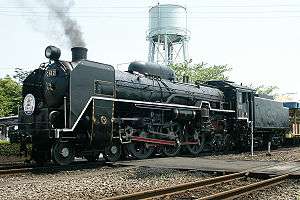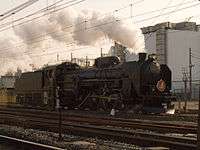JNR Class C61
| Class C61 |
|---|
|

Preserved C61 2 at Umekoji Museum, May 2003 |
|
|
| Specifications |
|---|
Configuration:
|
|
|---|
| • Whyte |
4-6-4 Hudson |
|---|
| Gauge |
1,067 mm |
|---|
| Length |
20,375 mm |
|---|
| Total weight |
78.10 t |
|---|
|
| Performance figures |
|---|
| Maximum speed |
100 km/h[1] |
|---|
|
The Class C61 (C61形) is a former class of steam locomotives operated in Japan. The class was the first type in Japan to use the 4-6-4 "Hudson" wheel arrangement. A total of 33 locomotives were built between 1947 and 1949, (one in 1947, 19 in 1948, and 13 in 1949). The locos were not built entirely from new, however, but used the boilers from former D51 2-8-2 "Mikado" freight locomotives.[2]
The immediate post-war years saw a dramatic decline in freight, while at the same time passenger traffic once again surged, requiring a programme to rapidly build new passenger locos (classes C57 and C58) as well as rebuilding passenger locos from former freight types (classes C61 and C62). These nominal conversions were also seen as a way of bypassing the difficulties in obtaining approval from GHQ (or Supreme Commander for the Allied Powers) for building completely new locomotives at the time.
The locomotives were notable in being the first in Japan to incorporate automatic stokers.
The first eighteen locos delivered were allocated to Utsunomiya and Sendai depots to work express passenger duties on the Tōhoku Main Line. Nine locos were allocated to Oku and Mito depots to work on Jōban Line duties, and six locos were delivered to Tosu depot in Kyūshū to work on the Kagoshima Main Line. With the spread of electrification together with the influx of C59s displaced from Tōkaidō Main Line duties, the C61s found themselves gradually pushed further north to Morioka and Aomori depots. In later years, they were to be seen at the head of the newly inaugurated Hakutsuru limited express (between Sendai and Aomori) and the Hayabusa blue train (between Hakata and Kagoshima).
With the completion of electrification from Morioka to Aomori in October 1968, the six last remaining C61s were moved to Aomori depot where they worked on the Ōu Mainline between Akita and Aomori. The six Kagoshima-based locos originally delivered new to Kyūshū were withdrawn, but the six remaining Tōhoku locos were transferred to Miyazaki depot in October 1971 to work on the Nippō Main Line between Miyazaki and Kagoshima. They worked there until finally being withdrawn in 1974.
Specifications
| Overall length |
20,375 mm |
| Overall height |
3,980 mm |
| Driving wheel diameter |
1,750 mm |
| Total operating weight |
78.10 t (excluding tender) |
| Boiler capacity |
7.4 m3 |
| Boiler pressure |
15.0 kgf/cm² |
| Cylinder dimensions |
500 mm dia. x 660 mm stroke |
Fleet details
(Source: [3])
| Number |
Boiler from |
Rebuilt by |
Date rebuilt |
Date withdrawn |
Last depot allocation |
| C61 1 |
D51 615 |
Mitsubishi Heavy Industries |
30 Nov 1947 |
5 Aug 1966 |
Sendai |
| C61 2 |
D51 1109 |
Mitsubishi Heavy Industries |
31 Jul 1948 |
|
|
| C61 3 |
D51 1063 |
Mitsubishi Heavy Industries |
22 Aug 1948 |
31 Mar 1966 |
Sendai |
| C61 4 |
D51 1011 |
Mitsubishi Heavy Industries |
31 Aug 1948 |
25 Dec 1967 |
Sendai |
| C61 5 |
D51 1075 |
Mitsubishi Heavy Industries |
29 Sep 1948 |
31 Mar 1966 |
Sendai |
| C61 6 |
D51 1134 |
Mitsubishi Heavy Industries |
18 Oct 1948 |
13 Mar 1969 |
Aomori |
| C61 7 |
D51 1147 |
Mitsubishi Heavy Industries |
30 Oct 1948 |
10 Jan 1968 |
Aomori |
| C61 8 |
D51 1117 |
Mitsubishi Heavy Industries |
16 Nov 1948 |
31 Mar 1966 |
Sendai |
| C61 9 |
D51 925 |
Mitsubishi Heavy Industries |
29 Nov 1948 |
20 Aug 1968 |
Aomori |
| C61 10 |
D51 1047 |
Mitsubishi Heavy Industries |
14 Dec 1948 |
31 Mar 1966 |
Sendai |
| C61 11 |
D51 1139 |
Mitsubishi Heavy Industries |
5 Jan 1949 |
1 Oct 1968 |
Aomori |
| C61 12 |
D51 1143 |
Mitsubishi Heavy Industries |
28 Feb 1949 |
19 Dec 1970 |
Kagoshima |
| C61 13 |
D51 1115 |
Mitsubishi Heavy Industries |
19 Mar 1949 |
19 Dec 1970 |
Kagoshima |
| C61 14 |
D51 1124 |
Mitsubishi Heavy Industries |
31 Mar 1949 |
19 Dec 1970 |
Kagoshima |
| C61 15 |
D51 1084 |
Mitsubishi Heavy Industries |
27 Apr 1949 |
25 Dec 1967 |
Sendai |
| C61 16 |
D51 1128 |
Mitsubishi Heavy Industries |
19 May 1949 |
10 Oct 1968 |
Aomori |
| C61 17 |
D51 1130 |
Mitsubishi Heavy Industries |
31 May 1949 |
5 Aug 1966 |
Sendai |
| C61 18 |
D51 874 |
Mitsubishi Heavy Industries |
19 Jun 1949 |
18 Jan 1974 |
Miyazaki |
| C61 19 |
D51 1027 |
Mitsubishi Heavy Industries |
28 Jul 1949 |
18 Nov 1973 |
Miyazaki |
| C61 20 |
D51 1094 |
Mitsubishi Heavy Industries |
31 Jul 1949 |
18 Nov 1973 |
Miyazaki |
| C61 21 |
D51 1123 |
Mitsubishi Heavy Industries |
31 Aug 1949 |
25 Dec 1967 |
Taira |
| C61 22 |
D51 1158 |
Nippon Sharyo |
25 Sep 1948 |
10 Oct 1968 |
Aomori |
| C61 23 |
D51 1010 |
Nippon Sharyo |
30 Sep 1948 |
5 Aug 1966 |
Sendai |
| C61 24 |
D51 1135 |
Nippon Sharyo |
4 Oct 1948 |
7 Nov 1972 |
Miyazaki |
| C61 25 |
D51 366 |
Nippon Sharyo |
8 Oct 1948 |
31 Mar 1966 |
Sendai |
| C61 26 |
D51 198 |
Nippon Sharyo |
28 Oct 1948 |
31 Mar 1966 |
Sendai |
| C61 27 |
D51 1146 |
Nippon Sharyo |
31 Oct 1948 |
31 Mar 1966 |
Sendai |
| C61 28 |
D51 904 |
Nippon Sharyo |
25 Nov 1948 |
20 Aug 1973 |
Miyazaki |
| C61 29 |
D51 69 |
Nippon Sharyo |
29 Nov 1948 |
20 Aug 1973 |
Aomori |
| C61 30 |
D51 1134 |
Nippon Sharyo |
11 Dec 1948 |
11 Dec 1968 |
Aomori |
| C61 31 |
D51 945 |
Nippon Sharyo |
22 Dec 1948 |
19 Dec 1970 |
Kagoshima |
| C61 32 |
D51 1050 |
Nippon Sharyo |
31 Jan 1949 |
19 Dec 1970 |
Kagoshima |
| C61 33 |
D51 1148 |
Nippon Sharyo |
2 Mar 1949 |
19 Dec 1970 |
Kagoshima |
Preserved examples

C61 20 (Feb. 2011)
See also
References
- 1 2 JR全車輌ハンドブック2009 [JR Rolling Stock Handbook 2009]. Japan: Neko Publishing. 2009. ISBN 978-4-7770-0836-0.
- ↑ Inoue, Kōichi (1999). 国鉄機関車辞典 (JNR Locomotive Encyclopedia). Japan: Sankaido. ISBN 4-381-10338-6.
- ↑ "C61形ハドソン機のプロフィール". Japan Railfan Magazine. Vol. 50 no. 587. Japan: Kōyūsha. March 2010. pp. 74–83.
- ↑ Jumo Shimbum: 上越線で復元のC61試運転 (27 April 2011). Retrieved 4 June 2011 (in Japanese)
Japanese Railway Locomotives |
|---|
| Steam locomotives | | |
|---|
| Diesel locomotives | |
|---|
| Electric locomotives | |
|---|


